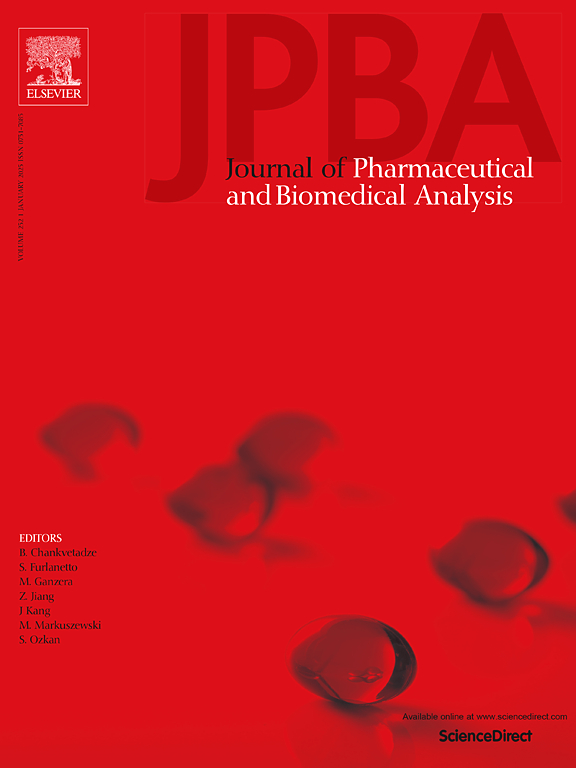Assessment of the hepatoprotective effects of Bicyclol's forced degradation products using a zebrafish model
IF 3.1
3区 医学
Q2 CHEMISTRY, ANALYTICAL
Journal of pharmaceutical and biomedical analysis
Pub Date : 2025-04-04
DOI:10.1016/j.jpba.2025.116871
引用次数: 0
Abstract
Bicyclol (BIC), a synthetic hepatoprotective agent widely prescribed in China, lacks comprehensive safety and activity profiles for its degradation products (DPs). Here, we systematically investigated BIC’s forced degradation behavior using ultra-high performance liquid chromatography coupled with quadrupole time-of-flight mass spectrometry (UPLC-QTOF-MS). Three hydrolytic degradation products (DP1-DP3) were isolated via HPLC and structurally characterized, revealing methylenedioxy group hydrolysis as the primary degradation pathway. Molecular docking simulations demonstrated enhanced target binding affinities of DPs compared to BIC, supported by absorption, distribution, metabolism, and excretion (ADME) predictions showing improved drug-likeness. In an alcohol-induced fatty liver zebrafish model, both BIC and its DPs attenuated hepatic macrovesicular steatosis and inflammatory responses. Mechanistically, treatment normalized lipid metabolism by downregulating alcohol-induced expression of FASN, SREBP1, PPARα, and PPARγ, while reduced IL-6 and TNF-α levels confirmed anti-inflammatory efficacy. These findings demonstrate that BIC DPs exhibit dual pharmacological activity through lipid homeostasis modulation and inflammation suppression, providing critical insights for quality control and therapeutic applications.
利用斑马鱼模型评估双环醇强制降解产物的肝保护作用
双环醇(BIC)是一种在中国广泛使用的合成肝保护剂,其降解产物(DPs)缺乏全面的安全性和活性分析。本文采用超高效液相色谱-四极杆飞行时间质谱法(UPLC-QTOF-MS)系统地研究了BIC的强制降解行为。通过高效液相色谱分离得到3个水解降解产物(DP1-DP3),并对其结构进行了表征,表明亚甲二氧基水解是主要的降解途径。分子对接模拟显示,与BIC相比,DPs的靶结合亲和力增强,吸收、分布、代谢和排泄(ADME)预测显示,DPs的药物相似性得到了改善。在酒精诱导的斑马鱼脂肪肝模型中,BIC及其DPs均可减轻肝大泡性脂肪变性和炎症反应。机制上,治疗通过下调酒精诱导的FASN、SREBP1、PPARα和PPARγ的表达来正常化脂质代谢,同时降低IL-6和TNF-α水平证实了抗炎疗效。这些发现表明,BIC DPs通过调节脂质稳态和抑制炎症表现出双重药理活性,为质量控制和治疗应用提供了重要见解。
本文章由计算机程序翻译,如有差异,请以英文原文为准。
求助全文
约1分钟内获得全文
求助全文
来源期刊
CiteScore
6.70
自引率
5.90%
发文量
588
审稿时长
37 days
期刊介绍:
This journal is an international medium directed towards the needs of academic, clinical, government and industrial analysis by publishing original research reports and critical reviews on pharmaceutical and biomedical analysis. It covers the interdisciplinary aspects of analysis in the pharmaceutical, biomedical and clinical sciences, including developments in analytical methodology, instrumentation, computation and interpretation. Submissions on novel applications focusing on drug purity and stability studies, pharmacokinetics, therapeutic monitoring, metabolic profiling; drug-related aspects of analytical biochemistry and forensic toxicology; quality assurance in the pharmaceutical industry are also welcome.
Studies from areas of well established and poorly selective methods, such as UV-VIS spectrophotometry (including derivative and multi-wavelength measurements), basic electroanalytical (potentiometric, polarographic and voltammetric) methods, fluorimetry, flow-injection analysis, etc. are accepted for publication in exceptional cases only, if a unique and substantial advantage over presently known systems is demonstrated. The same applies to the assay of simple drug formulations by any kind of methods and the determination of drugs in biological samples based merely on spiked samples. Drug purity/stability studies should contain information on the structure elucidation of the impurities/degradants.

 求助内容:
求助内容: 应助结果提醒方式:
应助结果提醒方式:


